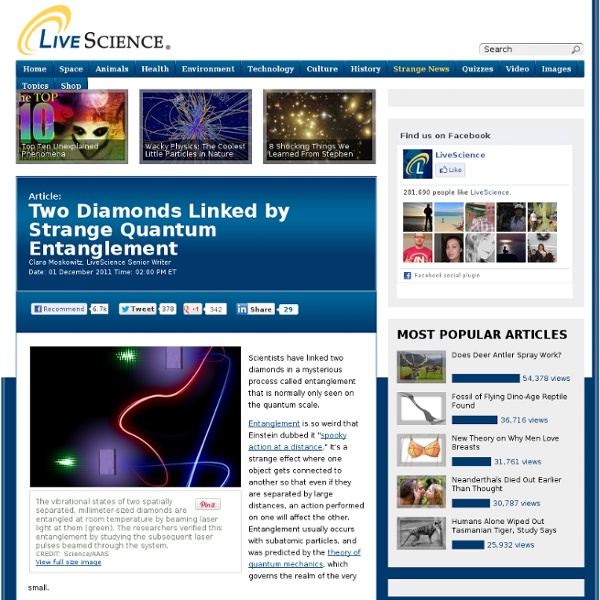DNA molecules can 'teleport', Nobel Prize winner claims
A Nobel Prize winning biologist has ignited controversy after publishing details of an experiment in which a fragment of DNA appeared to ‘teleport’ or imprint itself between test tubes. According to a team headed by Luc Montagnier, previously known for his work on HIV and AIDS, two test tubes, one of which contained a tiny piece of bacterial DNA, the other pure water, were surrounded by a weak electromagnetic field of 7Hz. Eighteen hours later, after DNA amplification using a polymerase chain reaction, as if by magic the DNA was detectable in the test tube containing pure water. Oddly, the original DNA sample had to be diluted many times over for the experiment to work, which might explain why the phenomenon has not been detected before, assuming that this is what has happened. The phenomenon might be very loosely described as 'teleportation' except that the bases project or imprint themselves across space rather than simply moving from one place to another. What does all of this mean?
Physics Community Afire With Rumors of Higgs Boson Discovery | Wired Science
One of the biggest debuts in the science world could happen in a matter of weeks: The Higgs boson may finally, really have been discovered. Ever since tantalizing hints of the Higgs turned up in December at the Large Hadron Collider, scientists there have been busily analyzing the results of their energetic particle collisions to further refine their search. “The bottom line though is now clear: There’s something there which looks like a Higgs is supposed to look,” wrote mathematician Peter Woit on his blog, Not Even Wrong. According to Woit, there are rumors of new data that would be the most compelling evidence yet for the long-sought Higgs. The possible news has a number of physics bloggers speculating that LHC scientists will announce the discovery of the Higgs during the International Conference on High Energy Physics, which takes place in Melbourne, Australia, July 4 to 11. The new buzz is just the latest in the Higgs search drama.
The mention of “spin” of a particle is one that... - Say It With Science
Free particle
Atoms Reach Record Temperature, Colder than Absolute Zero
Absolute zero is often thought to be the coldest temperature possible. But now researchers show they can achieve even lower temperatures for a strange realm of "negative temperatures." Oddly, another way to look at these negative temperatures is to consider them hotter than infinity, researchers added. This unusual advance could lead to new engines that could technically be more than 100 percent efficient, and shed light on mysteries such as dark energy, the mysterious substance that is apparently pulling our universe apart. An object's temperature is a measure of how much its atoms move — the colder an object is, the slower the atoms are. Bizarro negative temperatures To comprehend the negative temperatures scientists have now devised, one might think of temperature as existing on a scale that is actually a loop, not linear. With positive temperatures, atoms more likely occupy low-energy states than high-energy states, a pattern known as Boltzmann distribution in physics.
Personal and Historical Perspectives of Hans Bethe
Macroscopic quantum phenomena
Quantum mechanics is most often used to describe matter on the scale of molecules, atoms, or elementary particles. However some phenomena, particularly at low temperatures, show quantum behavior on a macroscopic scale. The best-known examples of macroscopic quantum phenomena are superfluidity and superconductivity; another example is the quantum Hall effect. Between 1996 to 2003 four Nobel prizes were given for work related to macroscopic quantum phenomena.[1] Macroscopic quantum phenomena can be observed in superfluid helium and in superconductors,[2] but also in dilute quantum gases and in laser light. Quantum phenomena are generally classified as macroscopic when the quantum states are occupied by a large number of particles (typically Avogadro's number) or the quantum states involved are macroscopic in size (up to km size in superconducting wires). Consequences of the macroscopic occupation[edit] Fig.1 Left: only one particle; usually the small box is empty. with Ψ₀ the amplitude and
Density matrix
Explicitly, suppose a quantum system may be found in state with probability p1, or it may be found in state with probability p2, or it may be found in state with probability p3, and so on. By choosing a basis (which need not be orthogonal), one may resolve the density operator into the density matrix, whose elements are[1] For an operator (which describes an observable is given by[1] In words, the expectation value of A for the mixed state is the sum of the expectation values of A for each of the pure states Mixed states arise in situations where the experimenter does not know which particular states are being manipulated. Pure and mixed states[edit] In quantum mechanics, a quantum system is represented by a state vector (or ket) . is called a pure state. and a 50% chance that the state vector is . A mixed state is different from a quantum superposition. Example: Light polarization[edit] The incandescent light bulb (1) emits completely random polarized photons (2) with mixed state density matrix .
Amplituhedron
An amplituhedron is a geometric structure that enables simplified calculation of particle interactions in some quantum field theories. In planar N = 4 supersymmetric Yang–Mills theory, an amplituhedron is defined as a mathematical space known as the positive Grassmannian. The connection between the amplituhedron and scattering amplitudes is at present a conjecture that has passed many non-trivial checks, including an understanding of how locality and unitarity arise as consequences of positivity. Research has been led by Nima Arkani-Hamed. Edward Witten described the work as “very unexpected" and said that "it is difficult to guess what will happen or what the lessons will turn out to be. Description[edit] Using twistor theory, BCFW recursion relations involved in the scattering process may be represented as a small number of twistor diagrams. Implications[edit] See also[edit] References[edit] Notes[edit] Bibliography[edit] External links[edit]



